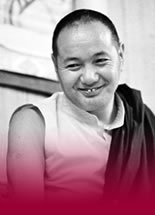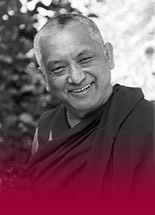Robina’s Blog
20 April, 2023
When I first met Lama Yeshe and Lama Zopa Rinpoche, at Chenrezig Institute in Queensland, Australia, in 1976, I knew I wanted a spiritual path but I didn’t know I needed a spiritual teacher: a mentor, a lama, a guru.
The fact is, whatever we learn, the best way – the only way – to learn it is to learn it from a person who embodies that knowledge: a rigdzin, knowledge-holder. Apparently guru means “heavy with qualities.” It’s so logical.
I was immediately drawn to Lama Yeshe. When he talked, the Dharma made sense. Lama Zopa was the main teacher for the month-long lamrim course. It was clear he was a perfect example of the teachings he gave, but it was Lama who grabbed my heart. Six months later, back home in Melbourne, it became clear to me that he was my lama. I confessed to one of my sisters that I had found a guru, “but please don’t tell anyone” I said! It was still a fairly new concept to me and I was a bit embarrassed about it.
I went to Kopan Monastery in Kathmandu, the lamas’ base, a year later and became a nun, taking my first rabjung vows from Rinpoche. During my three-month purification retreat at Tushita Retreat Centre in Dharamsala soon after, I had a vivid dream in which many of us students were with Rinpoche at the Nalanda Monastery ruins near Rajgir in India. Rinpoche called me over and put his text wrapped in cloth over one of my shoulders and his yellow robes over the other and told me to “follow him out.”
It was a nice dream but I didn’t think about any meaning. I happened to mention it to a lama in Dharamsala and he said, “Oh, that’s the lama who’ll lead you to enlightenment.” I was very surprised. I appreciated Rinpoche, but I didn’t see him as my lama. He seemed remote to me, somehow too holy, too high.
Over the years, especially after Lama passed away in 1984, I knew I had to nourish this relationship with Rinpoche. I had to create the merit. In my heart I’d make offerings, I’d pray and make requests. I’d see Rinpoche at various centers; he’d just crack jokes with me, say hello, nothing more. I was not ready.
This is such a crucial point. We the disciple choose our lamas. In this sense we are the boss: we decide who we want to teach us. And, as Pabongka Rinpoche says, we need to choose our lamas very carefully “because we’re going to end up like them.”
It’s so logical. We know we can’t be forced to learn something: we have to want it. I decided to make a cake only when I was about 25. I asked my mother to show me – not because I was just being kind to her but because I’d done my due diligence: checked on her qualities, checked her students – my sisters made excellent cakes — and checked with her peers, who valued her knowledge.
And why would I do that? Because I had no experiential knowledge of cakes. Now, at least, even though I didn't know from my own experience what she told me to do was valid, having done my due diligence I had inferential certainty: I could trust her.
She had the knowledge all along, but I wasn’t ready. Then I asked her and she showed me how to make a cake. And I remember vividly the day, the kitchen, the cake: it’s firmly in my memory. Why? Because it was the first time that cakes became real for me. I received a transmission of that knowledge from my mother's mind directly into mine.
As Lama Yeshe says, Buddha is no longer here, so we receive the teachings from the teacher, the person in front of us who holds the knowledge: and it’ll be only then that the teachings become real for us.
It took my heart ten years to catch up with what my mind knew: that Lama Zopa Rinpoche was my lama. At Mahamudra Centre in New Zealand, in 1987, at the end of a retreat with Rinpoche, Rinpoche called me up to his room. Since my ordination I’d been working full time in England for Wisdom Publications but now that job was over. I had no idea what to do next. Out of the blue, at least to me, Rinpoche casually mentioned that I should “go to Sydney and teach.” I’m not sure whether Vajrayana Institute wanted a teacher, especially such an inexperienced one, but that’s what I did!
In my mind I visualize that meeting like that Michelangelo fresco of God pointing his finger — go to Sydney and teach!
Now Rinpoche has left his holy body and all I can do is keep practicing what he taught me, keep fulfilling his wishes, and keep praying fervently that he returns as quickly as possible to us.

